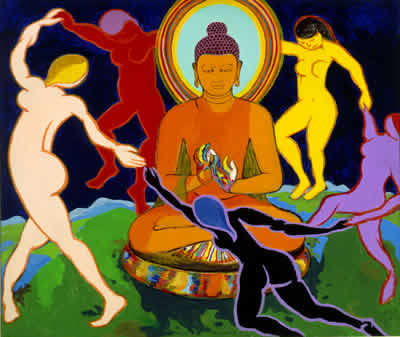
Neo-Iconography Art

WHAT IS NEO-I?
Neo-Iconography is a daring new form of artistic creation. It unites East and West, past and present, by organizing and combining familiar icons in unfamiliar ways, defying time, space, and cultural barriers, resulting in stunning eclectic compositions, with new meanings and messages. “Neo-I” is a daring art form because it challenges both the artist and viewer to be enchanted by new meanings for established images. Each painting has a visual impact with a philo-sophical underpinning and a cultural mission: to advocate Chen’s vision of a “Global New Renaissance rooted in Love.”

World Family in Peace
Lawrence Jeppson, the art critic and a former consultant to the Smithsonian Institution who coined this term said:
Neo-Iconography is a stunning paradox: an artistic symbolic resplendence that thrusts deeply into the esthetic future by appropriating every sort of images recognized from the past. This incandescent creator of Neo-Iconography, Dr. Tsing-fang Chen, relentlessly manipulates every variety of images from the public memory and experience to create new realities, spectacles, esthetic astonishments, and psychological/philosophical collisions!
At the heart of this unique style is Dr. Chen’s perception of the future of world culture: his “Five-Dimensional Universal Culture,” which he formulated in 1969,
After witnessing the American astronauts’ landing on the Moon in 1969, Dr. Chen saw that finally, after centuries of clashes between the East and West, a united global culture was being born. From this global culture, a new spirit and new energy have been emerging that affect everything from the arts to the sciences — and how people communicate ideas. Dr. Chen chose to dedicate his life and art towards advocating a “Global New Renaissance in Love.” As a vanguard of this new culture, Chen initiated “Neo-I” in the early 1970s and developed his artistic creation towards an “art for humanity’s sake,” which expressed his vision of our “Global Village.”

East and West I
“Neo-I” stands as an important aspect of Post-Modernism, and has been featured in over 300 textbooks and art books in 33 countries, including the University-level art history textbook Arts & Ideas by Professor W. Fleming.
WHAT IS NEO-I?
Neo-Iconography is a daring new form of artistic creation. It unites East and West, past and present, by organizing and combining familiar icons in unfamiliar ways, defying time, space, and cultural barriers, resulting in stunning eclectic compositions, with new meanings and messages. “Neo-I” stands as an important aspect of Post-Modernism, and has been featured in over 200 textbooks and art books in 33 countries, including the University-level art history textbook Arts and Ideas by Professor W. Fleming.
The Neo-Iconography of Dr. T.F Chen:
A Daring New Form of Communication
What exactly is Neo-Iconography? Lawrence Jeppson, the art critic and consultant for the Smithsonian Institution who coined this term said: “Neo-Iconography is a stunning paradox: an artistic symbolic resplendence that thrusts deeply into the esthetic future by appropriating every sort of image recognized from the past. This incandescent creator of Neo-Iconography, Dr. Tsing-fang Chen, relentlessly manipulates every variety of image from the public experience to create new realities, esthetic astonishments, and psychological/philosophical collisions!”
So, Neo-Iconography is a synthesis of many ideas and images. At the heart of this style is Dr. Chen’s perception of the future of world culture: the “Five-Dimensional Universal Culture,” which he formulated into a kind of cultural theory in 1969, getting revelation from the American astronauts’ landing on the Moon.
Dr. Chen believes that finally, after centuries of clashes between the cultures of the East and West, a united global culture is being born. From this global culture, a new spirit and new energy are emerging that affect everything from the arts to the sciences — and how people communicate ideas. Such kind of vision inspired Dr. Chen to advocate a global new Renaissance in “Love”(in reference to Teilhard de Chardin) expressed through his art as well as his action and way of life. Being a vanguard of a new culture, Chen initiated “Neo-Iconography” in the early 1970s and developed his artistic creation towards “art for humanity’s sake,” sharing his concern for our “Global Village.”
Neo-iconography is a new form of communication. It unites East and West, past and present, by organizing and combining familiar “icons” in unfamiliar ways. An icon is an image that has symbolic meaning, whether social, historical, religious, scientific, or aesthetic. Dr. Chen gathers icons from around the world, and places them together in contexts that defy time, space, and cultural barriers. The result is an eclectic composition, which may be startling, puzzling, joyful, sorrowful or humorous. “Neo-I” is a daring art form because it challenges both the artist and the viewer to be enchanted by new meanings for established images. Each painting has a visual impact with a philosophical underpinning and cultural mission: a global new Renaissance in “Love.”
